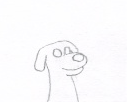The twelve principles of animation include the following:
Squash and Stretch; this principle gives the illusion of weight and speed, for example a bouncing ball may squash in shape when it hits the floor,stretching back into shape when it becomes airborne on the way back up.
Anticipation; anticipation communicates what is going to happen, for example when a character goes to jump, they bend their knees to build up the energy in order to jump - this is anticipation. you could argue that for every action there is anticipation.
Staging; staging gives us the ability to communicate the mood of a character/ scene, to communicate one idea at once and to enhance the atmosphere you are trying to cultivate through shot framing etc.
Straight ahead & Pose to Pose; straight ahead animation is animation that does not have key frames for the animator to follow and the animator makes up the movement of an object/character as he/she goes.
Pose to pose animation is animation that makes use of key frames, certain points in an object or character's movement that are extremes of that given movement e.g at the beginning, middle, and end points of a character jumping.
Follow through & overlapping action; this is when the main body of an object or character has stopped moving and things like hair, limbs, clothing, string etc carry on moving in the same direction for a short duration of time.
Slow out & Slow in; as an action begins more frames are needed at the beginning to show the movement speeding up, this is also true for the end of an action whereby more frames are needed to show the momentum decreasing in a movement. A good example of slow out & slow in would be an animated pendulum swing.
Arcs; ALL actions follow an arc or a circular path
Secondary action; a secondary action is an action that reinforces the effect of the first, an example of this could be the sneeze after the initial build up.
Timing; a mixture of low and fast timing can add texture and interest to an animation, however this can only really be perfected through practice and experience.
Exaggeration; exaggeration does not have to be large exaggerated movements, it is possible to exaggerate things like, a character's mood very subtly with subtle changes in expression
Solid Drawing: It is essential to have a good level of technical competence when it comes to drawing. This makes things more believable with things like depth, size and scale.
Appeal or Character Personality; a character needs to have a certain charm/likeability to keep the audience interested.

















































